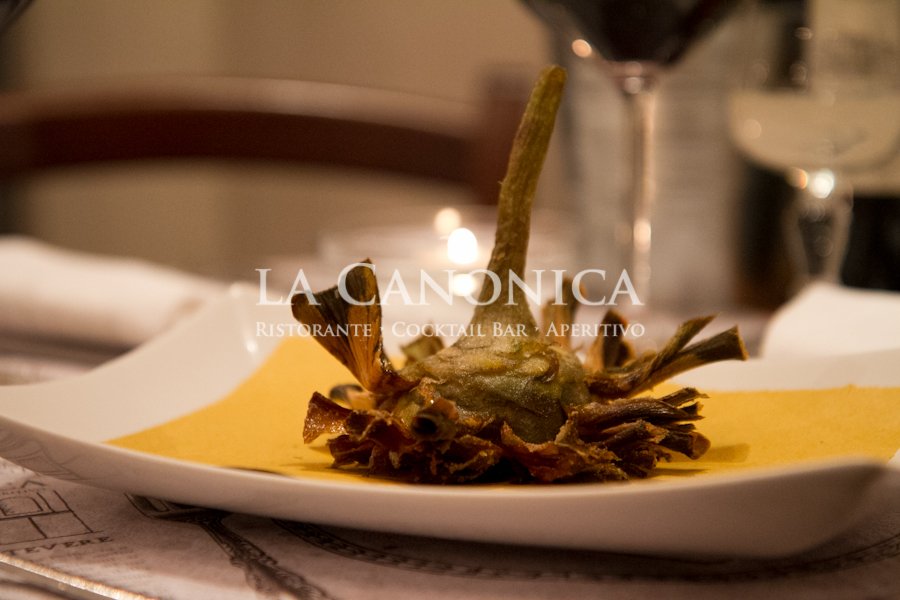Its scientific name is "Cynara Scolymus," in memory of the unfortunate maiden who escaped Jupiter's advances and was turned into a thorny plant. The etymological origin of the word comes from the Arabic "al-kaharshûf." Marilyn Monroe was in 1949 the first queen elected in the special festival held annually in Castroville, California, and Pablo Neruda (Nobel Prize for Literature in 1971), dedicated an ode to it. It was routinely consumed as early as the time of the Egyptians and was much loved at the time of the Romans, who ate it boiled in water or in wine, as indeed evidenced by the writings of some authors such as Columella (in De Rustica), Pliny (in Naturalis Historia) and Hesiod (in Works and Days).Certain news about its cultivation in Italy dates back to the 15th century, when the cultivation of the artichoke from Campania spread as far as Tuscany, and then also reached France, the chosen land of Catherine de' Medici, who was particularly fond of it.In the Middle Ages the artichoke changed status. No longer considered "food for the poor," as Eratosthenes of Cyrene defined it, but an ornament for sculptures, a symbol with alchemical references, it became the decorative motif of the capitals that supported Chartres cathedral.Today it is the symbol of traditional cuisine, the gluttonous spring flower par excellence.There are many varieties of artichoke, which can be grouped according to different criteria. According to the presence or absence of thorns, one distinguishes between "thorny" and "unarmed" varieties; according to the color of the flower head, one classifies the "violet" and "green" varieties; and finally, according to behavior in the phenological cycle, artichokes are diversified between autumn and spring varieties.They should be counted among the most famous varieties the "Spinoso Sardo," also cultivated in Liguria, a region that enhances it during the spring period as the basic ingredient of torta pasqualina, the "Catanese," the "Verde di Palermo," the "Mammola Verde," the "Romanesco," the "Violetto di Toscana," the "Precoce di Chioggia," the "Violetto di Provenza" and the "Violetto di Niscemi."Eternalized already by the Etruscans in the tombs of Tarquinia, with its peculiar shape, it still inspires painters such as Massimo Catalani, who makes this vegetable one of the most cherished motifs of his art.It has accompanied the gastronomic culture of the peoples of Central Italy since time immemorial and has become a fundamental ingredient of the Mediterranean diet. From appetizers to first courses, from main courses to side dishes, the restaurant industry offers a wide selection of dishes that employ the artichoke. Particularly popular in classic recipes, the "artichoke-mania" has led to the development of sophisticated dishes suitable for the most demanding palates. Fried, sautéed, roasted, boiled, pickled in oil, steamed, there really is something for everyone.There is a precise technique for cleaning the vegetable. All or part of the stem should be removed, depending on how you want to cook it. You discard the outer leaves and cut off the top of the remaining ones, leaving only the clear ones. Then you cut off the tip, turn the bottom discarding the tough, fibrous rind. Before cutting into wedges, the bottom should be dug slightly to remove the hay. To keep it from blackening, it is essential that the artichoke remains during cleaning and before cooking in water with lemon juice. Be careful, however, the knife used for cleaning must be strictly made of sharp iron.The Romanesco artichoke is thornless, green, spring-like and is also called "cimarolo" or "mammola".Coldiretti defines it as having a "spherical shape, compact, with a hole at the apex, color from green to violet, diameter not less than 10 cm. It is cultivated and harvested from January to May in some municipalities in the provinces of Viterbo, Rome and Latina. "The Roman artichoke is the prince of Jewish-Roman cuisine of which a timeless classic is the recipe for artichoke alla giudia (to follow).In our territory it is Ladispoli that boasts on the artichoke the De.Co. mark, that is, a product with a municipal designation. Every year in spring, exactly in April, there is in fact the festival of the artichoke, which in 2015 reached its 65th edition.The cultivation of the vegetable in Ladispoli began in 1930 with two qualities: very early "Castellammare" and "Campagnano" which ripened late. Since World War II, artichoke cultivation became intensive in all neighboring farms. Hence the real boom, resulting from low processing costs and excellent qualitative and quantitative yields. Moreover, the area still lends itself to the cultivation of this vegetable today, thanks to favorable climatic conditions.However, let's not limit ourselves only to taste and the pleasure of the palate, the artichoke also has important digestive, diuretic and hepatoprotective properties. It contains calcium, manganese, potassium, phosphorus, iron, vitamins A and C. In the leaves and stem we find "cynarin," a special substance that can promote kidney diuresis and intestinal transit.In cosmetics, artichoke also makes a valuable contribution. Its juice tones the skin and is very effective in combating furunculosis, hives and skin irritations. In short, a real cocktail of active ingredients useful for the body and health.Perhaps because it was said to be particularly dear to the goddess Venus, it has also been attributed aphrodisiac properties. Mattioli, in the mid-1500s, wrote in his "Discourses": "[...] of artichokes cooked in meat broth are eaten with pepper in canteens and with avalanche to increase venereal appetites. "Aromaweb

